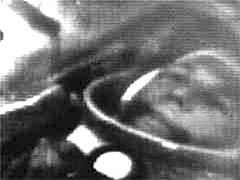
Vostok 1 was the first spaceflight of the Vostok programme and the first human orbital spaceflight in history. The Vostok 3KA space capsule was launched from Baikonur Cosmodrome on 12 April 1961, with Soviet cosmonaut Yuri Gagarin aboard, making him the first human to reach orbital velocity around the Earth and to complete a full orbit around the Earth.
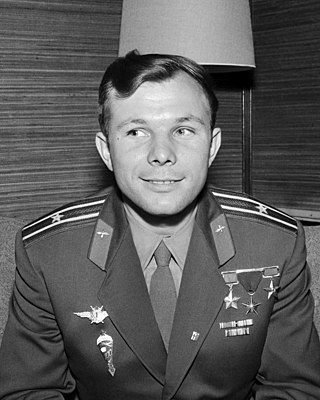
Yuri Alekseyevich Gagarin was a Soviet pilot and cosmonaut who, aboard the first successful crewed spaceflight, became the first human to journey into outer space. Travelling on Vostok 1, Gagarin completed one orbit of Earth on 12 April 1961, with his flight taking 108 minutes. By achieving this major milestone for the Soviet Union amidst the Space Race, he became an international celebrity and was awarded many medals and titles, including the nation's highest distinction: Hero of the Soviet Union.

Valentina Vladimirovna Tereshkova is a Russian engineer, member of the State Duma, and former Soviet cosmonaut. She was the first woman in space, having flown a solo mission on Vostok 6 on 16 June 1963. She orbited the Earth 48 times, spent almost three days in space, is the only woman to have been on a solo space mission and is the last surviving Vostok programme cosmonaut. She was the youngest woman to fly in space until 2023 when Anastatia Mayers flew on Galactic 02 at the age of 18. Since Mayers flew a suborbital mission, Tereshkova remains the youngest woman to fly in Earth orbit.

Vostok 2 was a Soviet space mission which carried cosmonaut Gherman Titov into orbit for a full day on August 6, 1961, to study the effects of a more prolonged period of weightlessness on the human body. Titov orbited the Earth over 17 times, exceeding the single orbit of Yuri Gagarin on Vostok 1 − as well as the suborbital spaceflights of American astronauts Alan Shepard and Gus Grissom aboard their respective Mercury-Redstone 3 and 4 missions. Titov's number of orbits and flight time would not be surpassed by an American astronaut until Gordon Cooper's Mercury-Atlas 9 spaceflight in May 1963.

Gherman Stepanovich Titov was a Soviet cosmonaut who, on 6 August 1961, became the second human to orbit the Earth, aboard Vostok 2, preceded by Yuri Gagarin on Vostok 1. He was the fourth person in space, counting suborbital voyages of US astronauts Alan Shepard and Gus Grissom. A month short of 26 years old at launch, he was the youngest person to fly in space until 2021 when Oliver Daemen flew on Blue Origin NS-16 at the age of 18. Since Daemen flew a suborbital mission, Titov remains the youngest man to fly in Earth orbit.

The Vostok programme was a Soviet human spaceflight project to put the first Soviet citizens into low Earth orbit and return them safely. Competing with the United States Project Mercury, it succeeded in placing the first human into space, Yuri Gagarin, in a single orbit in Vostok 1 on April 12, 1961. The Vostok capsule was developed from the Zenit spy satellite project, and its launch vehicle was adapted from the existing R-7 Semyorka intercontinental ballistic missile (ICBM) design. The name "Vostok" was treated as classified information until Gagarin's flight was first publicly disclosed to the world press.

Yuri's Night is an international celebration held every April 12 to commemorate milestones in space exploration. It is named for the first human to launch into space, Yuri Gagarin, who flew the Vostok 1 spaceship on April 12, 1961. In 2011, Yuri's Night was celebrated at over 567 events in 75 countries on seven continents. Yuri's Night is often called the "World Space Party". The launch of STS-1, the first Space Shuttle mission, is also honored, as it was launched 20 years to the day after Vostok 1, on April 12, 1981.

Vladimir Sergeyevich Ilyushin was a Russian military officer and a test pilot in the former Soviet space program. Ilyushin was son of Sergey Ilyushin whose career spent mostly as a test pilot for the Sukhoi OKB. After retiring from the space program, Ilyushin became a sport administrator and was inducted into the World Rugby Hall of Fame in 2013.

Korabl-Sputnik 5 or Vostok-3KA No.2, also known as Sputnik 10 in the West, was a Soviet spacecraft which was launched in 1961, as part of the Vostok programme. It was the last test flight of the Vostok spacecraft design prior the first crewed flight, Vostok 1. It carried the mannequin Ivan Ivanovich, a dog named Zvezdochka, television cameras and scientific apparatus.

Cosmonautics Day is an anniversary celebrated in Russia and some other post-Soviet states on 12 April. In Poland, an "International Day of Aviation and Cosmonautics" is celebrated on the same day. In 2011, at the 65th session of the United Nations General Assembly, 12 April was declared as the International Day of Human Space Flight in dedication of the first crewed space flight made on 12 April 1961 by the 27-year-old Soviet Russian cosmonaut Yuri Gagarin. Gagarin orbited the Earth for 1 hour and 48 minutes aboard the Vostok 1 spacecraft.

The Monument to the Conquerors of Space is a giant obelisk erected in Moscow in 1964 to celebrate achievements of the Soviet people in space exploration. It depicts a starting rocket that rises on its exhaust plume.

Gagarin's Start, also known as Baikonur Site 1 or Site 1/5 was a launch site at Baikonur Cosmodrome in Kazakhstan that was used for the Soviet space program and Roscosmos.
The Vostok-K, GRAU index 8K72K was an expendable carrier rocket used by the Soviet Union for thirteen launches between 1960 and 1964, six of which were crewed. It was derived from the earlier Vostok-L; however, it featured uprated engines to improve performance, and enlarge its payload capacity. It was a member of the Vostok family of rockets.
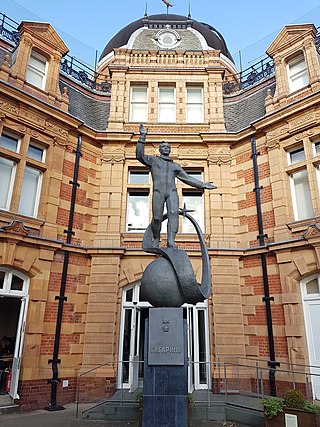
The Statue of Yuri Gagarin in Greenwich, London, is a zinc statue depicting the cosmonaut wearing a spacesuit and standing on top of a globe. The 3.5-metre (11 ft) high statue is a replica of an original by Anatoly Novikov in Lyubertsy, where Gagarin was trained as a foundry worker. It was a gift to the British Council from the Russian space agency Roscosmos as a part of several cultural events commemorating the 50th anniversary of the first human spaceflight.

Gagarin: First in Space a.k.a.. First man In Space is a 2013 Russian docudrama biopic about the first man in space, Yuri Gagarin, and the 1961 mission of Vostok 1. It was released by Central Partnership theatrically in Russia on June 6, 2013, and in the United Kingdom on DVD on June 23, 2014 by Entertainment One. The film's running time of 108 minutes approximates the time it took Gagarin to go around the Earth before returning. It stars Yaroslav Zhalnin as Soviet fighter pilot and cosmonaut Yuri Gagarin. The film received mixed reviews, with some critics praising the film's acting, direction and storytelling with others touching on the film's "cheap-looking" visual effects. The film received criticism for its state funding and ignoring the aftermath of the flight.
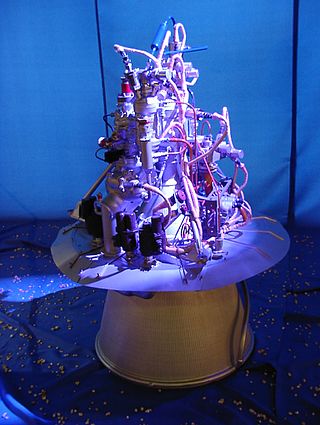
The RD-0109 is a rocket engine burning liquid oxygen and kerosene in a gas generator combustion cycle. It has single nozzle and is an evolution of the RD-0105. It was the engine used on the Vostok Block-E that launched Yuri Gagarin to orbit.

The International Day of Human Space Flight is the annual celebration, held on 12 April, of the anniversary of the first human space flight by Yuri Gagarin (USSR). It was proclaimed at the 65th session of the United Nations General Assembly on 7 April 2011, a few days before the 50th anniversary of the flight.

Alexander Nevsky Square, formerly called Red Square, is a city square in Tsentralny District, Saint Petersburg. It is at the east end of Nevsky Prospekt, linking the street with the Alexander Nevsky Lavra.

The Suvorov Monument is a bronze sculpture of Generalissimo Alexander Suvorov located in Saint Petersburg. It is at the centre of Suvorov Square, opposite the Field of Mars and the Trinity Bridge, and between the Marble Palace and the Saltykov Mansion.
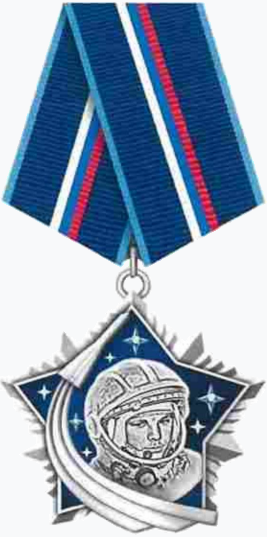
The Order of Gagarin is a high-ranking Russian award established to recognize outstanding contributions to the advancement of the Russian and Soviet space program. Named after the Soviet cosmonaut Yuri Gagarin, who became the first human to journey into space in 1961, the Order of Gagarin was created in 2023 in honor of the 60th anniversary of Valentina Tereshkova's solo mission on the Vostok 6 on 16 June 1963 and the 62nd anniversary of Yuri Gagarin's historic spaceflight aboard the Vostok 1 spacecraft.




















